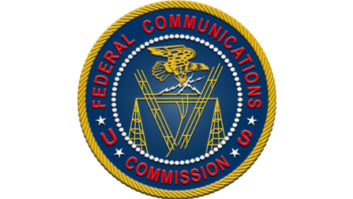WASHINGTON — More changes to longstanding radio ownership limits may be in the works, now that the Federal Communications Commission has kicked off its 2018 Quadrennial Review of its rules with a Notice of Proposed Rulemaking (MB Docket No. 18-349).
The NPRM — approved by Chairman Ajit Pai and Commissioners Michael O’Rielly and Brendan Carr, while Commissioner Jessica Rosenworcel dissented in part — asks for comment on the relevance of the Local Radio Ownership Rule, the Local Television Ownership Rule and the Dual Network Rule in the modern media marketplace. It also seeks opinions on three diversity proposals. (The national television ownership cap is not part of this review.)
The Republican majority continues to favor deregulation, indicating support for eliminating AM subcaps and possibly doing the same for FM stations. However, Democrat Jessica Rosenworcel, the partial dissenter, isn’t so sure that’s the answer to protect the interests of local communities and broadcasters, although she appears open to rethinking how radio ownership is regulated.
Pai issued a statement elaborating on the commission’s plans and intent for this review. “We want to know whether, given the current state of the media marketplace, we should retain, modify or eliminate any of them. We’re keeping an open mind as to what, if anything, should change, and we hope to develop a robust record to guide us on the best path forward.”
Pai cited the 2017 elimination of the newspaper-radio cross-ownership rule as an example of how deregulation could benefit the industry. He referenced the Grand Junction Daily Sentinel’s recent purchase of a Colorado radio station group and operator Jay Seaton’s plans “to disseminate news across more formats and appeal more to advertisers” because of the acquisition, serving the community and his bottom line.
Additionally, Pai said the review will follow up on the diversity work initiated in the 2010 and 2014 review orders.
However, the chairman took Commissioner Rosenworcel to task for her partial dissent; without mentioning her name, he characterized it overtly political. “I’m disappointed that we were unable to secure a unanimous vote … our dissenting colleague requested edits that did not comply with the law,” Pai said. He accused her of grandstanding, saying a request to delete the Dual Network Rule “from the Notice doesn’t constitute a good-faith attempt to reach consensus but rather gives the appearance of looking for an excuse to dissent for political reasons.”
Rosenworcel issued her own statement, explaining her concerns — and her hopes for the Quadrennial Review. She summarized her complaints: “It fails to honestly assess the impact of too many changes we propose on the values of localism, competition and diversity that have informed this agency’s media policies in the past — and I believe should still inform our efforts in the future.”
Rosenworcel expressed uneasiness about growing “news deserts,” or areas of the country “where national news dominates but local news is disappearing” — and questioned how further consolidation might expand this problem. She said, “Excessive consolidation is unlikely to increase diversity and more likely to make the ownership of outlets look less like the communities they serve.”
She criticized the proposed elimination of the Dual Network Rule and the idea that one company should be allowed to own unlimited FM and AM stations and added problems related to her pet cause, high-speed broadband access, to the mix.
But the Democratic commissioner wasn’t all doom and gloom. “In some ways, I believe today’s rulemaking meets this mark, including with its proposals to rethink limitations on the ownership of AM radio and the proposals to increase ownership diversity of broadcast entities deserve serious consideration,” Rosenworcel said.
Republican Commissioners Michael O’Rielly and Brendan Carr released statements in favor of the NPRM.
O’Rielly called it “a balanced effort to comply with our statutory obligation — itself the result of a bipartisan compromise.” But he did not miss the opportunity to throw shade at Rosenworcel, pointedly writing, “I realize that some outside parties — and perhaps some internally — would prefer that we abdicate this responsibility, especially given the extensive litigation history and inevitable challenges that will eventually result.”
Despite that opening, O’Rielly expressed optimism, describing the process as “a chance to reformulate our media ownership rules to reflect the current marketplace,” and writing, “At its heart, this proceeding is about good government practices.”
O’Rielly also acknowledged his own desire to push “the envelope further on our ultimate objective” — “more extensive relaxation of our rules” — but said the current “fairly benign document… appropriately tees up the relevant questions to allow for a meaningful comment process.”
He then argued it is no longer appropriate to say “certain audio or video offerings can be siloed into discrete segments. We must redefine and broaden the appropriate market definition to be consistent with consumer, advertising, and business realities.”
O’Rielly expressed keen interest in radio ownership rule reform. He noted “radio ownership rules have not undergone any significant changes since the 1990s” and indicated his desire to ditch “current AM-FM subcaps” and instead focus on “where to draw the line on the FM side, if at all, while permitting caps to be eliminated on the AM side.”
Commissioner Carr’s statement echoed Pai and O’Rielly’s support and added historical context for the institution of the ownership rules introduced in the 1940s by Chairman James Fly, who was concerned about “the dangerous radio duopoly” and the potential of newspaper companies acquiring broadcast networks — prospects that may be hard to fathom for modern constituents.
Carr also discussed the idea that “content has been liberated from its medium” — no longer isolated into television or radio programming or magazines, and with that in mind, he praised the “language that seeks additional comment on the relationship between the FCC’s market definition and the one used in reviews by the Department of Justice.”
Industry groups also weighed in.
NAB Executive Vice President of Communications Dennis Wharton released a statement emphasizing that the association is “not seeking wholesale elimination of these regulations, but rather a modernization that reflects today’s fiercely competitive marketplace.” He called on the FCC to update rules within the context that “broadcasting now competes head-to-head with powerful Internet, pay TV and audio companies that didn’t exist when many broadcast ownership rules were first written.”
Free Press Policy Manager Dana Floberg was considerably less positive. Floberg decried “so-called synergies” and said, “It’s become even more evident since the last agency review that media consolidation adversely affects both the quantity and quality of local news and information from competing sources and diverse owners.”
Floberg emphasized local broadcasters’ continued importance in the modern media landscape, especially for minority communities, despite the growth of digital. But she also called out “consolidated broadcasters” for “skirting” broadcast-ownership limits “by entering into secretive agreements to combine local newsrooms and station operations.” Additionally, Floberg argued, “The alleged benefits of consolidation haven’t materialized. Instead, the outcome is the same: layoffs of station staff, limited editorial independence, reduced investment in newsgathering and diminished competition for audiences and advertisers.” None of this, she says, serves the public interest, and Floberg concludes that “Chairman Pai needs reminding that it isn’t the FCC’s job to protect the broadcast industry’s profit margins. ”












